
On March 31, 1941, Marine Iron and Shipbuilding in Duluth, Minnesota, laid the keel for the first Coast Guard vessel of a Mesquite new buoy tender class, joining the so-called “Black Hull” fleet. The new vessel measured 180 feet overall and had a beam of 37 feet at the extreme. She had a displacement of 935 tons and drew 12 feet. Marine Iron and Shipbuilding made all but one, the Coast Guard cutter Ironwood (USCGC Ironwood), coming in for $1,388,277, was built at the USCG yard in Curtis Bay, Maryland, and was launched and commissioned in 1943.
USCGC Ironwood in the Pacific Theater
After shakedown, USCGC Ironwood departed Norfolk for War in the Pacific, arriving in Noumea, New Caledonia, via Bora Bora and Pago Pago in March 1944. During World War II, the Ironwood and her sister ships covered thousands of miles of open ocean, working to establish LORAN stations, moving and establishing mooring buoys, and carrying cargo, mail, and personnel between South Pacific islands. “Some accounts portray a more glamorous role for Ironwood. But a clear, no-nonsense look at her service seems more appropriate and respectful. Ironwood was never a frontline warship. She was always a workhorse blue-collar vessel that responded to every necessity.” US Coast Guard Together We Served currently lists 90 members who had served aboard her. She was decommissioned on October 6, 2000, and transferred to the Department of the Interior to serve as a vessel for the Jobs Corps Maritime Training Program at Tongue Point Center, Astoria, Oregon. Her namesake is a small tree or bush native to the midwest and south of the United States, Sideroxylon lanuginosum, which receives its common name from its extremely tough wood.
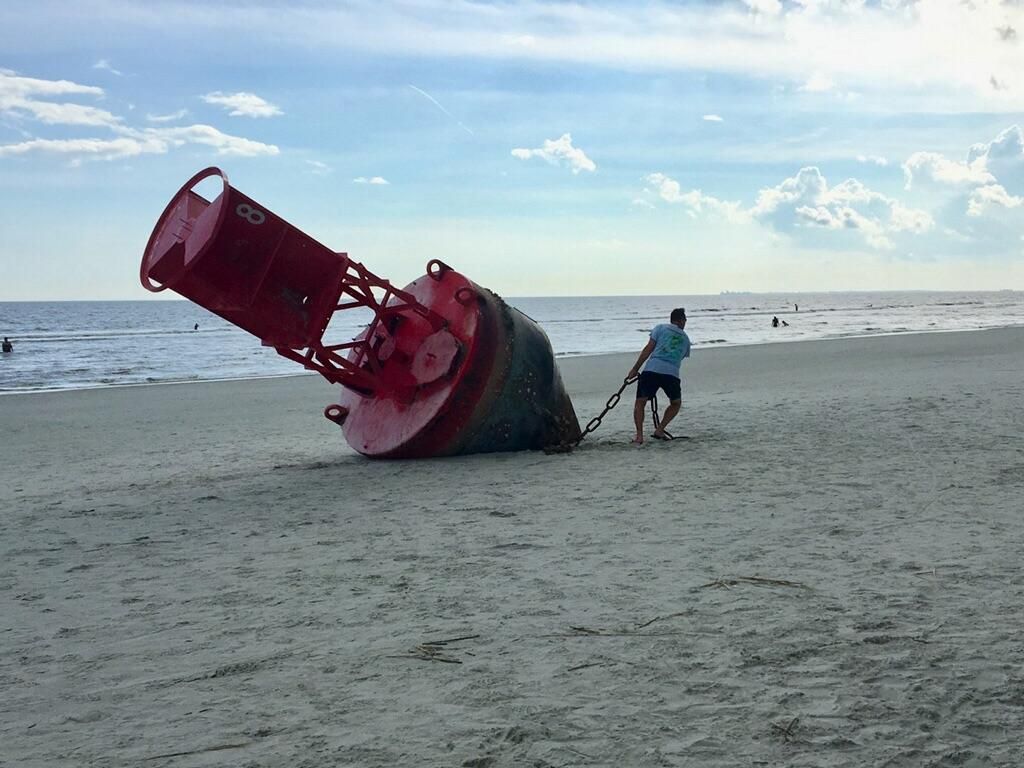
Primary Mission of USCGC Ironwood – Buoy Tending Operations
A buoy is a floating object anchored at a definite location to guide or warn mariners and mark the positions of submerged objects or moor vessels instead of anchoring. CGTWS member DC3 William Doherty provided the following general information about what would have been Ironwoods’ primary purpose. “Buoys come in several classes and weights depending on their use and location. Diameters range from 8-15 feet up to the monsters at 40 feet across. Two factors are water depth and location (river or ocean). A river buoy often uses steel cables as opposed to chain links. The sinker (weight) varies in size based on the speed of the current. Buoys can weigh several tons. They generally have about 40 feet of chain plus or minus a few feet to adjust for tide changes. Red and green buoys are used to mark channels so ships don’t go aground. There was an old adage when I was in that said, ‘Red, right, returning.’ That means you keep the red buoy on your right as you are returning to port. Huge blocks of concrete anchor the buoys. However, they still are subject to drift. A Black Hull (buoy tender) regularly checks buoy position to ensure it hasn’t drifted. Suppose it does then they have to drag it back to the proper coordinates. Black Hulls are the hardest-working cutters in the CG fleet. Using cranes on the ship they will hoist a buoy on board and literally scrape it to get rid of encrusted sea life, etc. It’s a filthy job, but someone has to do it!”
USCGC Ironwood’s Wartime Challenges and Missions
When attempting a unit history in any branch, the narrative is often more associated with the personnel serving in it than, in this case, a physical artifact the size of a maritime vessel like USCGC Ironwood. Everything that happened on that ship, from duties performed for nearly six decades by hundreds of people effectively in shifts to the weather, her cruises, and her most notable achievements, is all contained in the legend of the skin and bones of a ship, her logs, and books – becoming the symbolic diary of her service. Other than having served aboard her in person there’s no better way to get a feel for what Ironwood endured and performed than to see it as written by the Coast Guard’s own in their unique jargon.
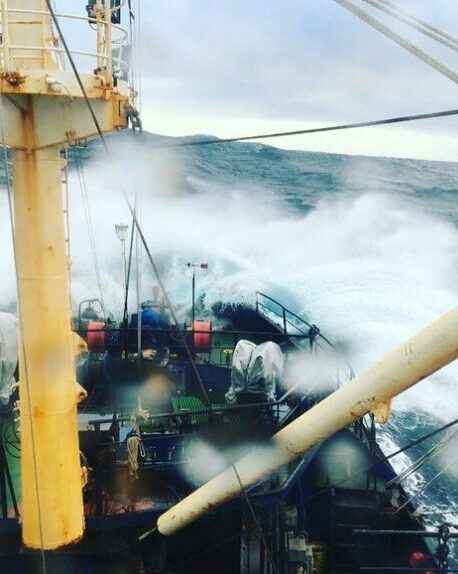
By far, the most incomparable, comprehensive, and accurate lineage and history of the Ironwood and its class of vessels is summarized on February 21, 2021, Department of Homeland Security report as follows: First assigned to Boston as permanent station, she was later reassigned to San Francisco to become effective on the date she departed the Coast Guard Yard. On 14 December 1943, she reported for her shakedown cruise to Commander-in-Chief, Atlantic Fleet and remained on shakedown and post-shakedown availability until 4 January 1944, when she got underway from Norfolk, VA, in company with the USCGC Mesquite for Key West, FL. En route on the 7th Coast Guard District, USCGC Ironwood began losing headway, and it was found that her propeller shaft was broken. She anchored off Jupiter Inlet Light and notified NOB, Key West, that she was disabled. She was towed by DE-51 on the 6th and later taken in tow by YMS-245, sent for the purpose from Key West. At Miami, YT-230 towed her to the Coast Guard Depot, where she underwent repairs until 28 January 1944, when she departed for Key West, arriving there on the 29th. From 29 January until 3 February 1944, her personnel underwent instruction at the Fleet Sound School at Key West, and the vessel underwent repairs until the 12th. On 12 February 1944, she got underway for the Panama Canal Zone, leaving Balboa on the 21st, operating independently from Nouméa, New Caledonia, via Bora Bora and Pago Pago. She arrived at her destination on 24 March 1944.
On 26 March 1944, Ironwood left Noumea to assist SS John Lind, grounded on a reef at 22 28 S, 166 36 E. Ironwood’s attempts to pull the vessel off being unsuccessful, she removed 65 Navy and Marine Corps personnel from the vessel on the 28th. She transported them to Nouméa on the next day. She remained until 2 April 1944, when she proceeded with Navy tugs USS Sioux and YT-463 to remove the reefed ship. In tandem with the tugs, they successfully re-floated John Lind on 6 April.
Afterward, Ironwood was ordered to return to Noumea.
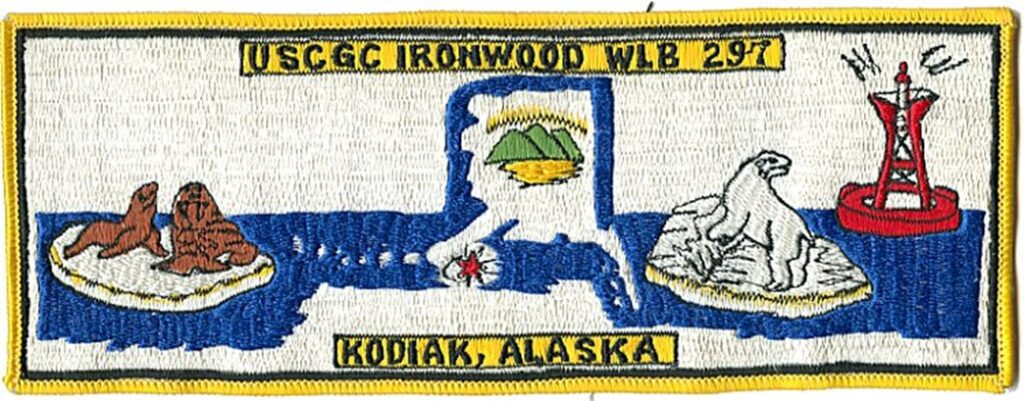
After availability for alterations and repairs, Ironwood took on a cargo for transshipment and then departed Noumea on 26 April 1944 for Suva, Viti, Levu, Fiji Islands, where she arrived on the 29th. Unloading her cargo of 30 tons of seed potatoes, she took on 51,975 pounds of miscellaneous cargo for Vunda Point, Viti Levu. From 1 May to 9 May 1944, the cutter was engaged in removing battleship mooring buoys and all their moorings in Tomba Ko Nandi Harbor, Viti Levu, and on the 10th. Ten enlisted Navy personnel reported aboard for transportation to Pago Pago, Tutuila, American.Samoa, arriving there on the 13th. From 14 May through the 23rd, she removed 12 anti-torpedo net buoys, two cruiser mooring buoys, and all other moorings, proceeding on the 24th to Apia, Upola, British Samoa, where she arrived the next day to remove 18 anti-torpedo net buoys and their moorings. She left Apia on 28 May 1944 for Nouméa, Ellice Islands, arriving there on 2 June 1944. She set a mooring buoy the same day, but the mooring slid into deep water and sank the buoy. On the 5th, she arrived at Funafuti and towed anti-torpedo nets from the north end of the harbor to the net depot. On the 7th, she departed for Nouméa with a new buoy and mooring equipment, which had been set by the 10th. She departed for Nouméa on the 13th, arriving at Little Roads Harbor on the 18th, and left for Great Roads Harbor on the 28th, where she entered drydock for painting, inspection, and repairs through 9 August 1944.

That same month, she departed for Port Nepui, towing a Navy pile driver. She returned to Nouméa on the 13th and, the next day, was released by the Commander, Service Squadron South Pacific, to the Commander, Naval Base Nouméa, for temporary duty. The cutter, thereupon, proceeded to remove, with its moorings, buoy A6 and reestablished it in anchorage area A3 as mooring buoy A3. This was followed by the removal of buoy A2. On the 18th, she proceeded to Great Roads Anchorage, Noumea. On the 22nd, she departed for Havannah Harbor, Efate Island, New Hebrides, arriving on the 23rd to remove buoy 16 and its moorings. Buoy 4 was found too heavy for Ironwood’s equipment. From 28 August through 28 September, the cutter was engaged in removing underwater harbor defenses and fleet moorings in Havannah and Fila Harbors, Efate, New Hebrides, including in all 12 buoys and 800 tons of mooring chains, as well as 180 anti-torpedo nets. On the 29th, she departed Havannah Harbor, towing a pontoon barge, which she discharged in Fila Harbor and proceeded to Noumea. Arriving at Noumea on 1 October 1944, and after an availability for repairs until the 13th, she was assigned to CNB, Noumea, departing on the 11th to replace three channel buoys and two obstruction buoys in Havannah Passage Channel. On the 23rd, she towed a Navy pile driver to Nepui, New Caledonia, returning to Noumea on the 25th, where she remained until 4 November 1944.
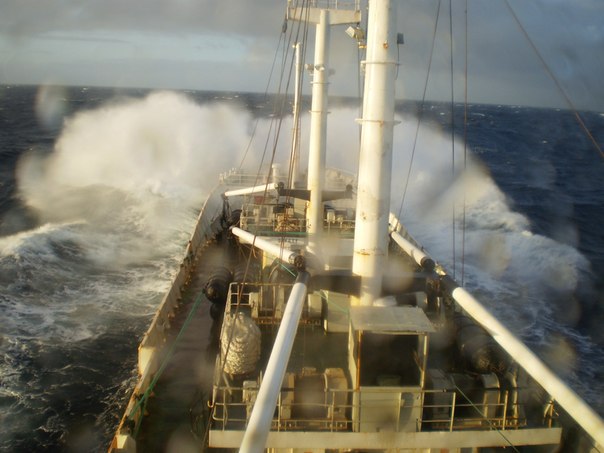
On 25 December 1944, USCGC Ironwood departed Noumea for Guadalcanal and reported to the Harbor Defense Officer, Tulagi area, Gavutu Harbor, Gavutu Island, Solomon Islands. On the 21st, she removed and reset two mooring buoys in Purvis Bay, Florida Island, and on the 27th, laid nine buoys at Dona Cove, Guadalcanal. Returning to Gavutu, she reestablished one buoy at the Tulagi Harbor entrance and reset another before moving to Gavutu Net Depot Dock on December 31, 1944. Serving under Commander Service Squadron, South Pacific, Ironwood proceeded on 3 January 1945 to Cape Esperance after picking up two divers and some mooring materials for use on a salvage job. From 4 January to the 9th, she was engaged in raising a Japanese two-man submarine submerged in about 30 feet of water off Cape Esperance. During these operations, she was moored by three lines leading from the port side to moorings, three lines leading from the starboard side, and secured ashore. Working from a small boat, divers used water pressure hose and crowbars to clear a space under the bow and stern of the sunken submarine. By the 9th, a space was cleared under the ship’s bow, and a 1.5″ chain sling was rigged around the bow of the underwater craft. Returning to Gavutu until the 19th she again anchored off Cape Esperance on the evening of the latter date where the divers had completed rigging the submarine for lifting, connecting the chain around bow and stern with a chain bridal. On the 20th, Ironwood got into position alongside the sunken sub, lowered the main hoist over the starboard side, and hooked it to the chain bridal. When the cutter had broken the submarine clear of the bottom and raised it to position, the sub was secured alongside. Ironwood towed it in that position into Hutchinson’s Creek, Florida Island, Solomon Islands, and anchored for the night. On the 21st, she moved to a new anchorage where the sub was transferred to a US Navy crane barge.
USCGC Ironwood: From WWII Pacific Operations to Alaskan Coast Duties
Proceeding to Dome Cove, Guadalcanal, the cutter removed 21 small craft moorings, then removed the moorings at Cape Esperance used in salvaging the Japanese sub. On 28 January 1945, USCGC Ironwood proceeded to Banika Island, Russell Islands, Solomon Islands, where she loaded materials for the Net Depot at Gavutu Island. During February, besides transporting mooring materials again from Bakina to Gavutu and to Kukum Dock, Guadalcanal, she established two mooring buoys in Purvis Bay for the Navy ARD-18 (Floating Drydock) and then anchored off Lunga Point, Guadalcanal for painting, repairs, and alterations. On 8 March 1945, she carried 2000 bags of mail. Banika Island, returning to Gavutu on the 10th. On the 25th, she entered the floating drydock on Lunga Point for scraping and repainting the ship’s bottom and checking and repairing the SONAR equipment. On the 28th, she removed two destroyer buoys and moorings from Purvis Bay. Through May 1945, she was engaged in removing fleet moorings from the anchorage area at Segond Channel, Espiritu Santo Island, New Hebrides, departing on 1 June 1945, for Renard Sound, Russell Islands, towing Navy Barge YC-698. After voyage repairs there from 4-12 June, Ironwood took YC-698 and the YF-247 in tow in tandem for Eniwetok, where she arrived on 22 June 22, 1945. Three days later, with the same two barges in tow, she departed for Guam. She arrived at Guam on 2 August 1945 and then proceeded to Leyte, Philippine Islands, where she arrived on 6 August 1945. Here, she was assigned to Commander 7th Fleet. From 6 August 1945 to July 1946, Ironwood was employed in tending aids to navigation in the Philippine Islands.
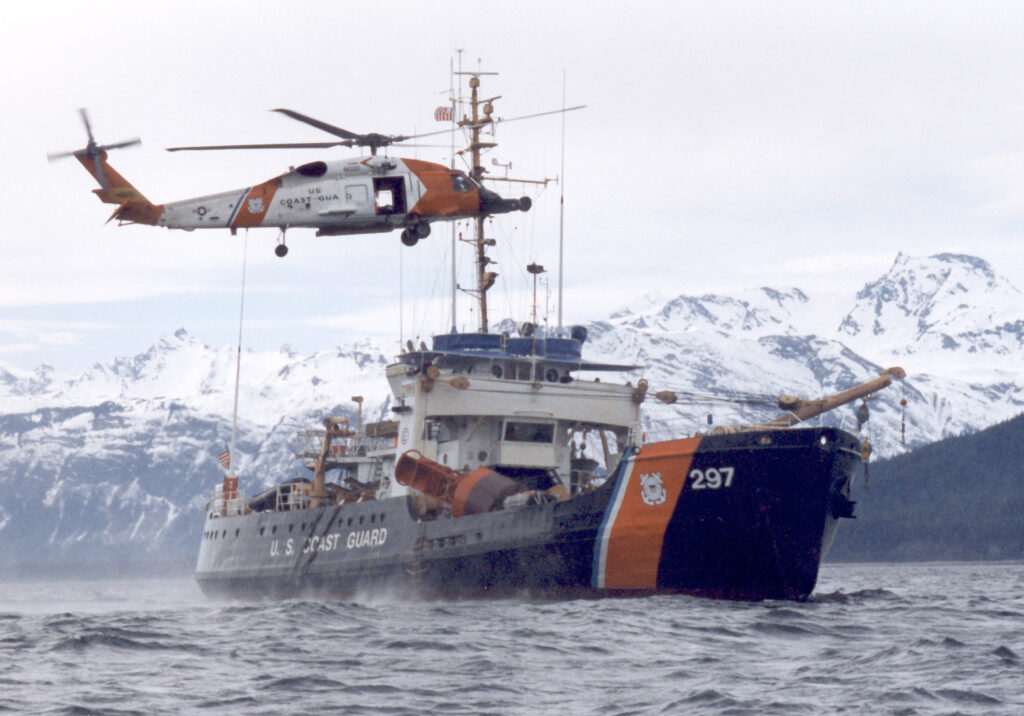
Juneau, AK (Summer 1996) — The U.S. Coast Guard cutter Ironwood (USCGC Ironwood), with assistance from a Coast Guard helicopter, offload equipment for maintanance on Eldred Rock Lighthouse. USCG photo by MILLER, LAIMAN B. LTJG.
From 25 July 1947-9 May 1950, Ironwood was stationed at Monterey, CA, and used for ATON. On 28 March 1948, the tender searched for a reported mine. On 12 October 1949, Ironwood assisted FV Victory at 36 40 N, 123 45 W. From 9 May 1950-12 July 1954, Ironwood was stationed at Guam and used for ATON and to service LORAN stations throughout the Pacific, including those at Okinawa, the Philippines, and Kwajalein. From 12 July 1954 to 26 October 1969, Ironwood was stationed at Honolulu, HI, and used for ATON and to service LORAN stations throughout the Pacific, including Okinawa, Kwajalein, and French Frigate Shoal. During 9-14 November 1957, Ironwood unsuccessfully searched for the missing Pan American Flight 994 and returned to Honolulu, HI, due to a cracked hull weld, escorted by USCGC Planetree. On 8 January 1959, Ironwood assisted the grounded sampan Bellatrix at Molokai Beach, HI. On 6 January 1962, Ironwood rescued the crew of FV Hiroshima Maru aground at 21 17 N, 157 51 W. On 23-25 May 1963, the cutter escorted the disabled MV Dianna to Honolulu, HI. On 18 February 1969, Ironwood towed the disabled FV Widgeon from Augustine Island to Homer, AK. Early in April 1969 escorted the distressed tanker Yukon, which was holed by a submerged object in Cook Inlet. On 29 April 1969, the crew fought a fire on the Shell Oil drilling platform in Cook Inlet. From 26 October 1969-13 July 1974, Ironwood homeported at Homer. On 26 December 1969, she hoisted the disabled FV Arctic Fox on board at MacArthur Cove and carried her to Seward, AK. From 13 July 1974-early 1975 Ironwood underwent a major overhaul at the Coast Guard Yard, Curtis Bay, MD. From early 1975 to 1 May 79, Ironwood was stationed at Adak, AK, and was used for ATON. From 1 May 1979-2000, it was stationed at Kodiak, AK, and used for ATON. On 23 October 1983, Ironwood seized FV Kiyo Maru No. 55 for underlogging its catch. In the Spring of 1989, the cutter assisted with cleanup operations in Prince William Sound after the grounding of the Exxon Valdez.
Read About Other Famous Military Units
If you enjoyed learning about USCGC Ironwood, we invite you to read about other Famous Units on our blog. You will also find military book reviews, veterans’ service reflections and more on the TogetherWeServed.com blog. If you are a veteran, find your military buddies, view historic boot camp photos, build a printable military service plaque, and more on TogetherWeServed.com today.
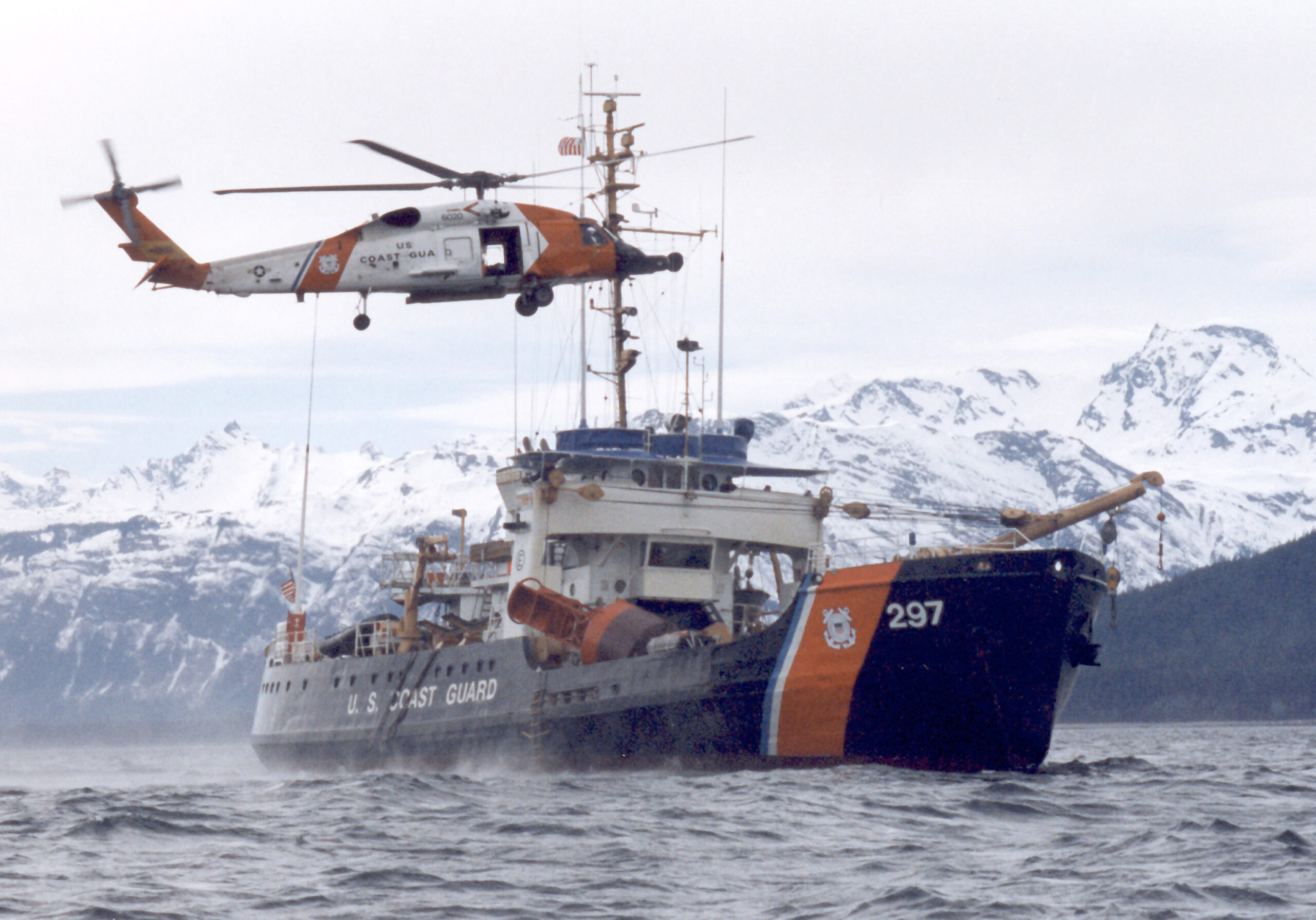
Need a story on the USCGC Cypress and especially since it’s been in Kodiak. There is no info at all on that ship since it arrived in AK.
I was on the Ironwood in 1967 while it was in Hawaii. I would like to have photos of Ironwood during the ’60s.